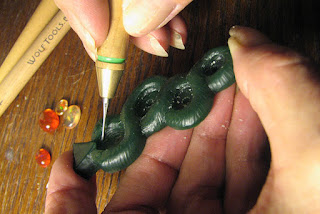What Is Lost Wax Casting? Troubleshooting Common Issues In Wax Modeling And Casting
An ancient method that dates back thousands of years, lost wax casting is a process that has stood the test of time. Today, it is still commonly employed in the jewellery industry, as well as in the art and sculpting sectors, to produce items that are elaborate and detailed. But despite its widespread use, only a small percentage of individuals are familiar with the intricate details of the lost wax casting process. A leading lost wax casting company intend to provide you with all of the knowledge that you need in order to make informed decisions about lost wax casting.
A
casting, also known as lost wax casting, is a procedure that involves casting a
single metal item from a wax model. This process is also known as
"investment casting." Because of its great degree of adaptability,
this method produces findings that are incredibly detailed. In this article,
you will learn how to begin the process of lost wax casting as well as how to
resolve the problems associated with wax making and casting, Read on!
The History of Lost Wax Casting and Its Primary
Origins
In
lost wax casting, a mold is constructed around a wax model that has been
sacrificed. The wax is melted off and formed into a hollow once the mold
investment has been set. This cavity is then used to allow the metal or glass
to flow in. By using this casting technique, it is possible to capture minute
features in both metal and glass. This technique has been used from the year
3000 B.C. in order to graphically record the narratives of ancient societies
and faiths over the course of history. To this day, artists and craftsmen all
around the globe continue to use this traditional method, so maintaining a
legacy that has been passed down through the years and continues to enchant art
fans and lovers alike.
Identifying and Resolving the Most Frequent Issues
in Wax Modeling and Casting
1. One
of the most important skills that any artisan should be able to learn in order
to guarantee that their products are successful and of excellent quality is the
ability to overcome typical problems that arise in wax casting. Working with
wax may be a satisfying and flexible media; yet, it also comes with its own set
of obstacles that may develop throughout the modeling and casting process.
These challenges can be quite difficult to overcome.
2. The
formation of air bubbles in the wax mold is a problem that is often encountered
by artistic craftspeople. The final product may become distorted and its
integrity may be compromised as a result of these bubbles. Before pouring the
wax into the mould, you should make sure that it has been completely degassed
by using a vacuum chamber or a pressure pot. Since this is the case, the gas
will not be able to make its way out.
3. In
addition, wax shrinkage or warping during the cooling process is an issue that
occurs rather often. This may lead to errors or malformations in the final cast
that is produced. If you want to solve this problem, you could either think
about using a wax of better quality that has a lower rate of shrinkage or you
should change the cooling temperature and the amount of time to get the results
you want.
4. Furthermore,
castings that are partial or faulty might be the result of the mold not being
filled to its full capacity or of the wax being distributed unevenly. One way
to prevent this from happening is to make sure that the wax is poured into the
mold in a leisurely and even manner, letting it to flow and fill all of the
complex features before it solidifies.
Conclusion
The
ability of artisans to overcome obstacles in wax modeling and casting,
eventually leading to an improvement in the quality and effectiveness of their
creative activities, may be achieved via an awareness of these typical concerns
and the use of effective approaches for troubleshooting challenges.




Comments
Post a Comment